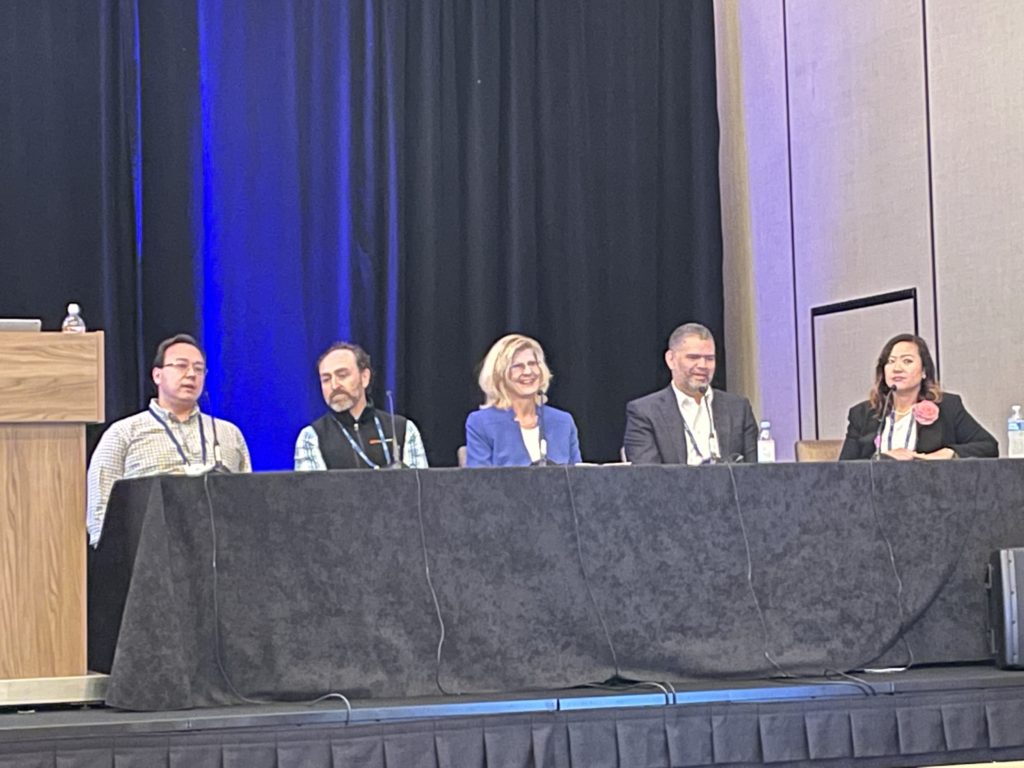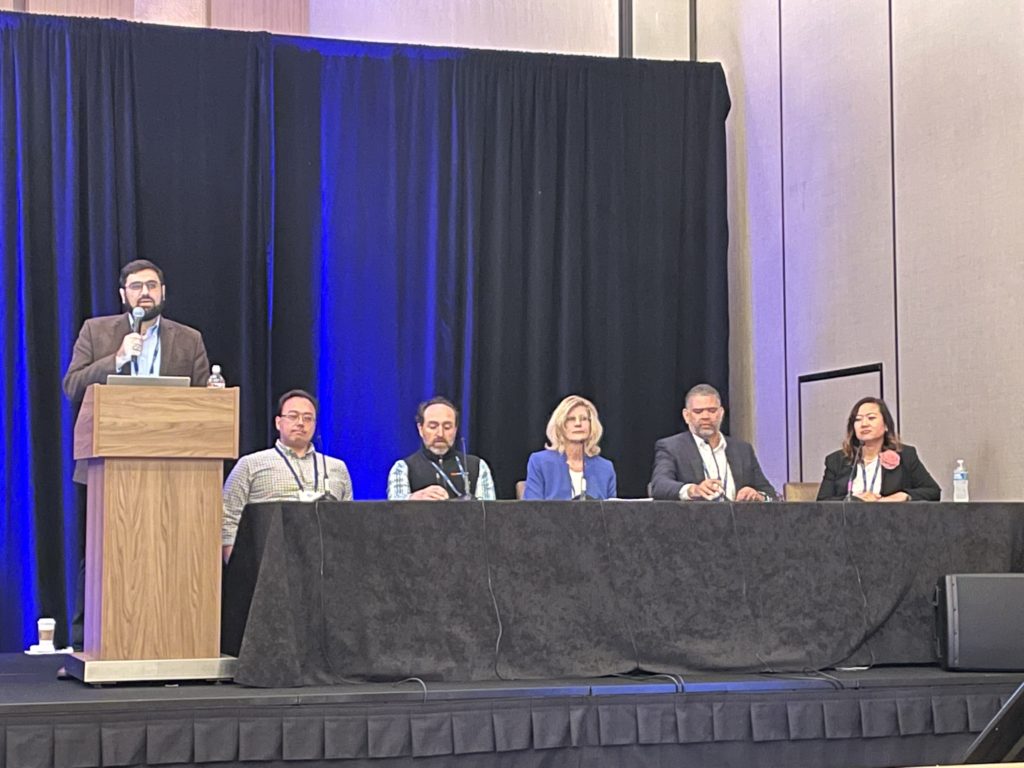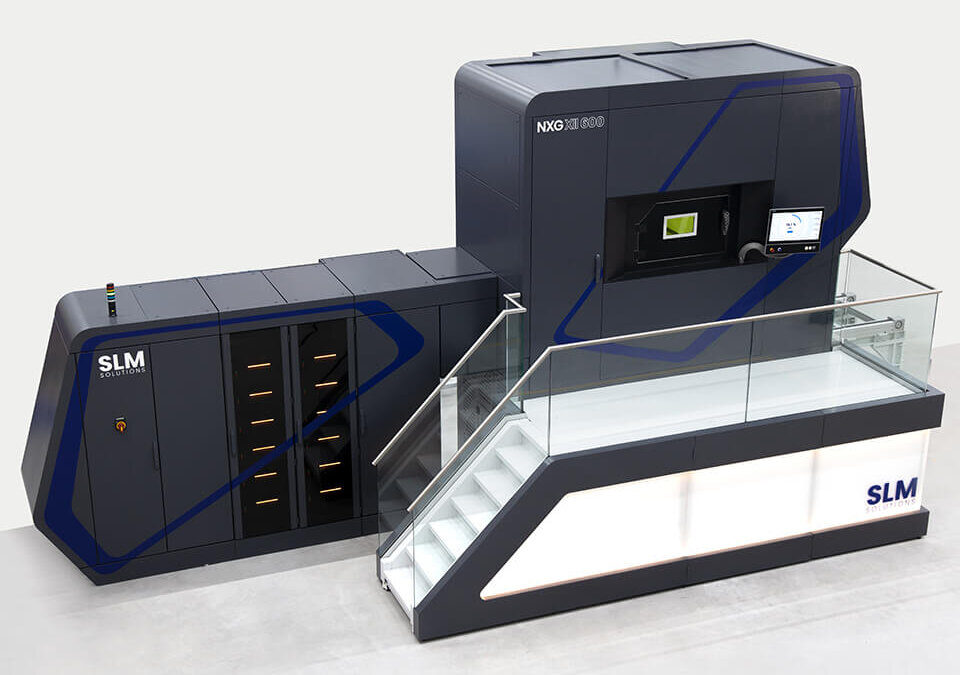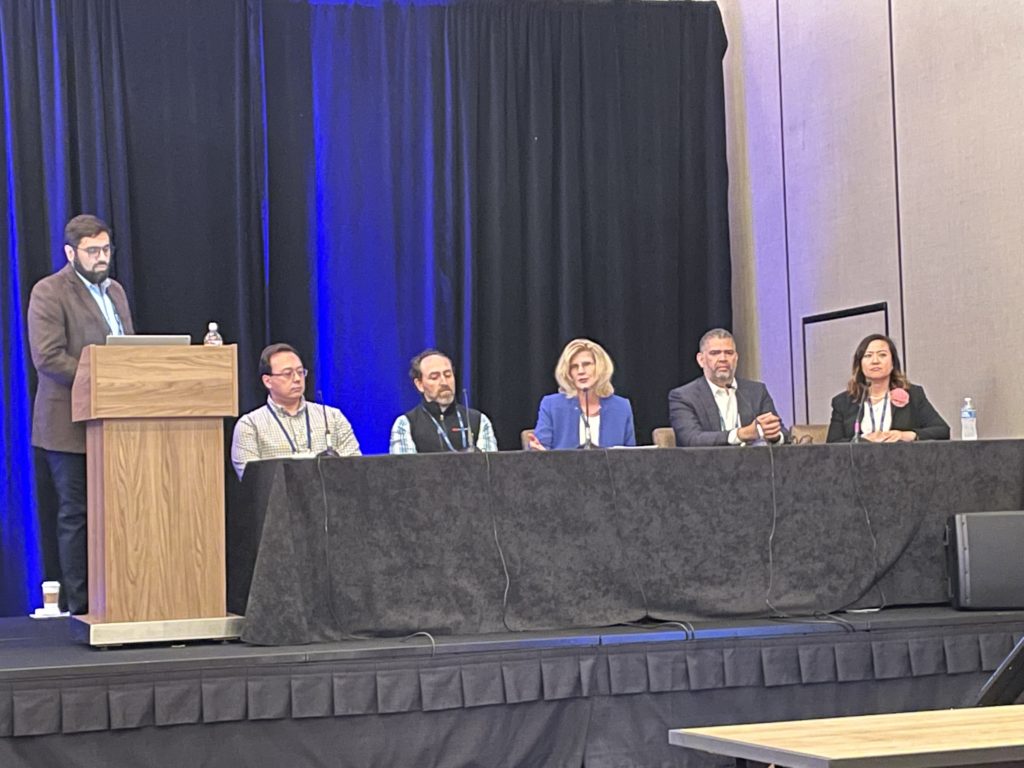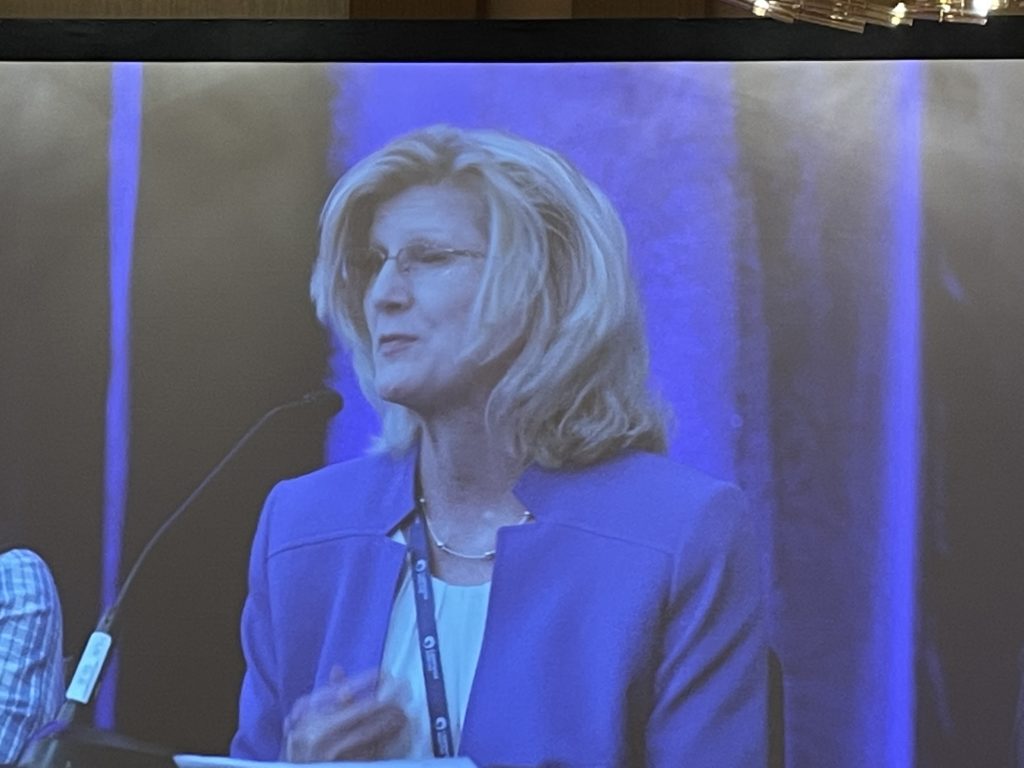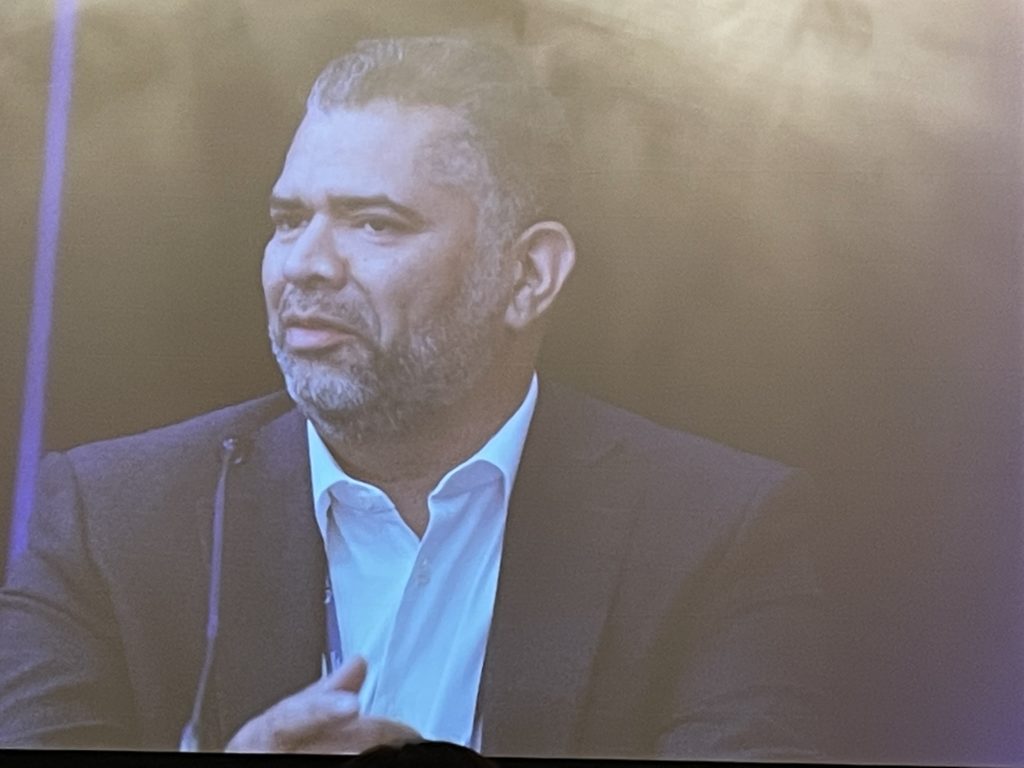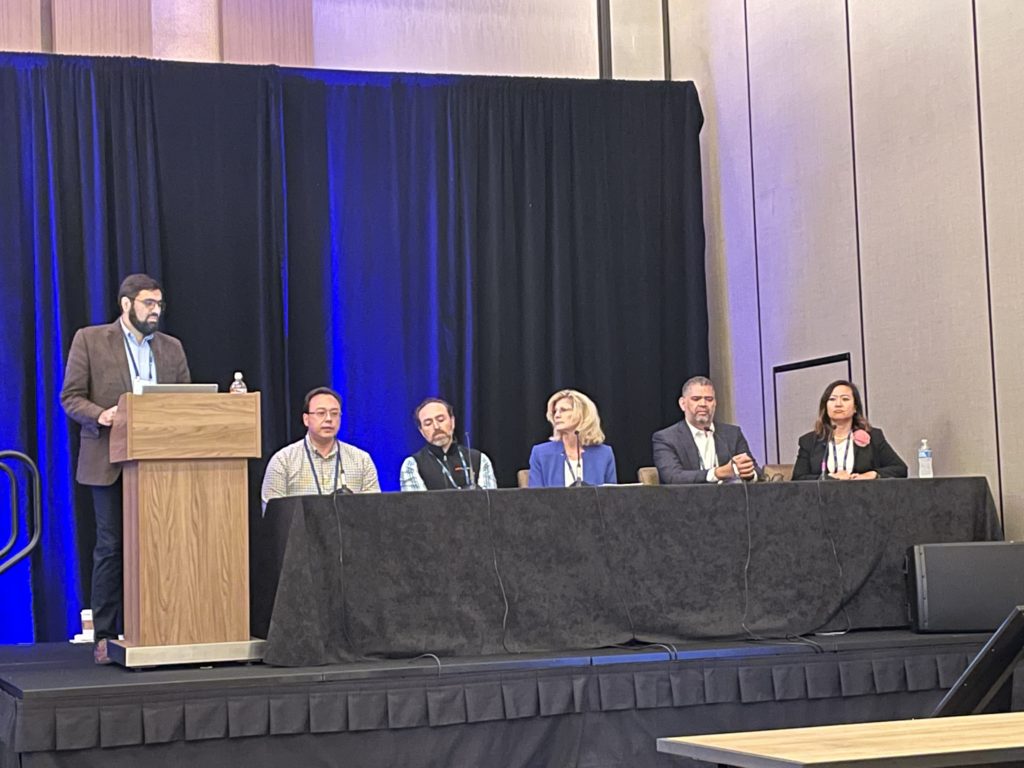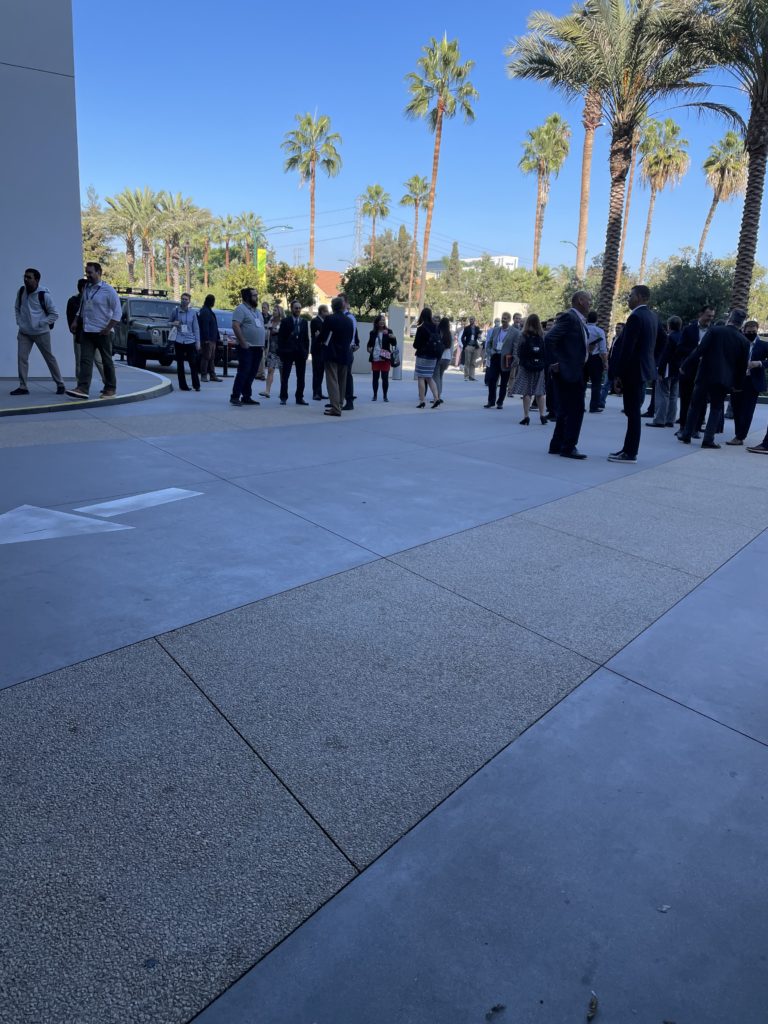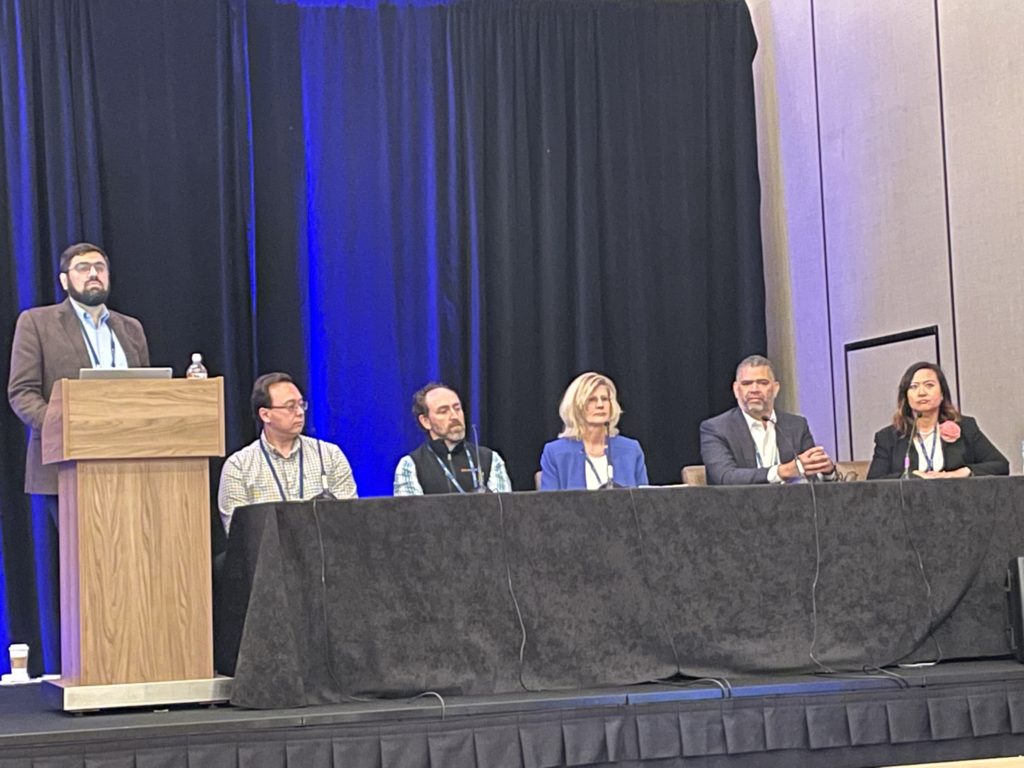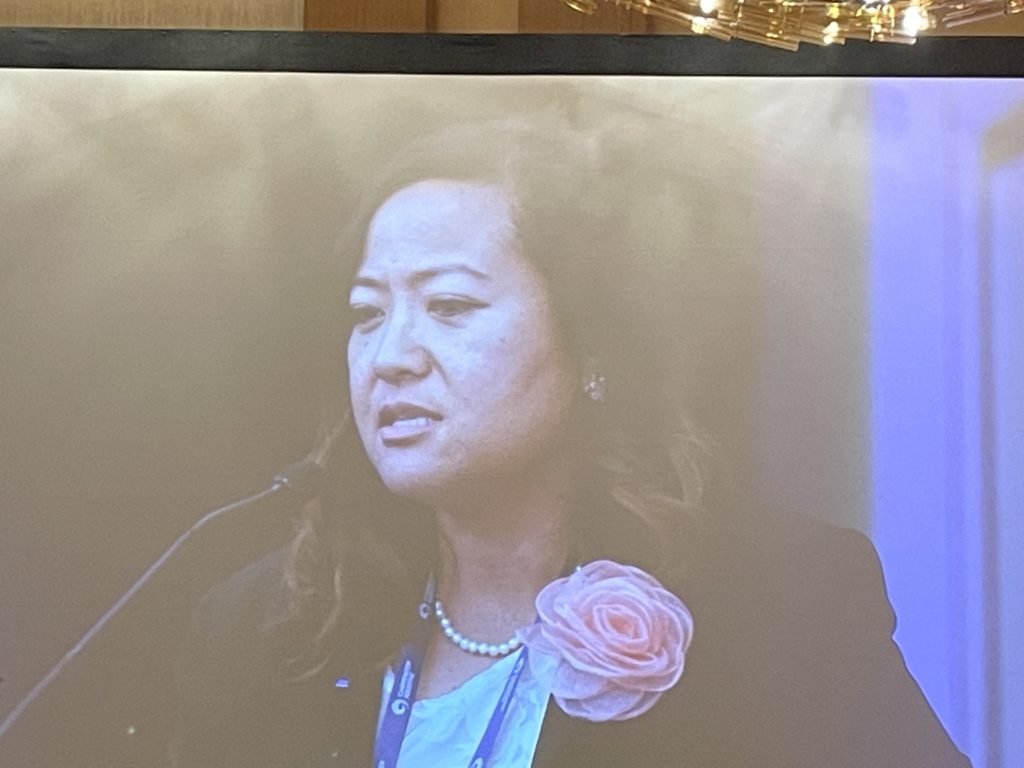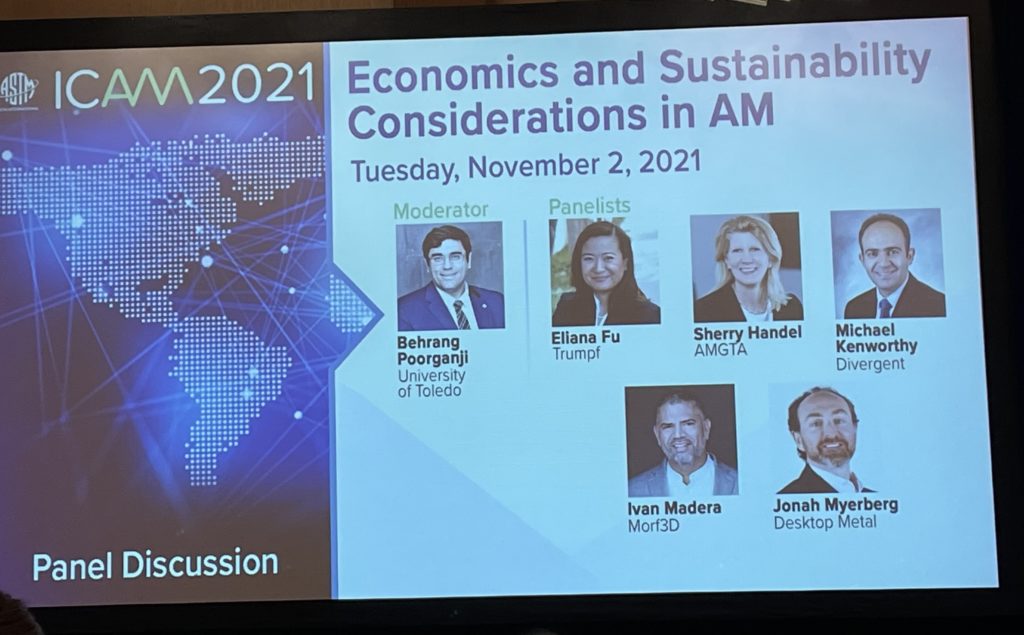I recently had the pleasure of attending the 2021 International Conference on Additive Manufacturing (ICAM), hosted by ASTM International’s Additive Manufacturing Center of Excellence (AMCOE) in Anaheim, California. The event, which featured over 550 presentations and plenty of time for networking, was a hybrid mix of live, streaming keynote presentations and panel discussions and on-demand symposia talks on topics ranging from feedstock, AM for defense applications, and environmental effects on 3D printed parts to application of AM in construction, 3D printing in the medical sector, mechanical testing and non-destructive evaluation methods, and more.
The second panel I attended, “Economics and Sustainability Considerations in AM,” featured Behrang Poorganji, Research Professor and Director of Advanced Manufacturing at the University of Toledo, as the moderator; he’d been a panelist the day before during a discussion on the biggest challenges for feedstock to enable AM to scale.
“Everything in the industry is growing, but we’re talking less about the economic sustainability,” Poorganji said. “After the pandemic, we’ve heard a lot about the circular supply chain and its impact. In this panel we want to talk about how additive manufacturing, as opposed to conventional manufacturing, will affect our economy.”
He introduced the panelists next, who all came from very different backgrounds. First there was Michael Kenworthy, CTO of Divergent Technologies, who was sitting next to Desktop Metal CTO Jonah Myerberg. Sherry Handel, Executive Director of the non-profit Additive Manufacturing Green Trade Association (AMGTA), was next, and then Ivan Madera, CEO and Founder of Morf3D. At the far end of the table was Eliana Fu, Industry Manager for Aerospace and Medical at TRUMPF North America.
To kick things off, Poorganji first asked Handel why life cycle assessment (LCA) research—a specific focus of AMGTA—was so important in economic sustainability. First, she explained that LCA was looking at a product, or a part, “from cradle to grave, basically from the beginning to its end of life, and that AMGTA is commissioning LCA studies that compare something like casting to powder bed fusion technology.
“In additive manufacturing, we are literally scratching the surface. There’s very limited research with life cycle assessment, and the research out there is in silos, so it’s not the whole picture,” Handel said. “We just announced two life cycle assessment projects in September, and we’re at the beginning of the process and looking for more life cycle assessment projects. We’ve got one coming up this winter on polymers, with one of our founding members.”
Handel said that there seems to be a lot of interest in sustainability, as last December AMGTA only had 14 members, and now there are 34 members from 11 different countries.
Myerberg spoke up and encouraged everyone in the room to get involved with what the AMGTA is doing. He explained that as a machine maker and material provider, Desktop Metal talks to a lot of customers, and helps answer their question of what benefits additive manufacturing offers, including weight and cost reduction, but “a big one is sustainability.”
“Why are we doing what we’re doing? This data that AMGTA is collecting can help answer that, and we could provide that front and center to customers and policy makers,” Myerberg continued.
Fu weighed in next, noting that in her old jobs, she would hear co-workers saying things about how they wanted bigger and bigger powder bed machines, and how they’re now getting bigger and bigger.
“Why aren’t we looking at these other processes that can get closer to actual net shape? I feel like these are getting left behind,” she said. “We’re moving at warp speed to build these bigger machines, we’re not thinking about the materials that will fill those hoppers, and how to deal with all the waste from those failed builds. Maybe we shouldn’t be going at breakneck speed, and instead take a thought for those other complimentary processes.”
Poorganji asked Madera how he, as a solution provider with Morf3D, sees “life cycle assessment, as a solution package you’re providing, from a sustainability standpoint?”
“I’m guilty,” Madera answered immediately. “That’s one of the things we’re looking at—reducing waste from a process standpoint by creating digital twins. That’s an extensive integration that has to happen with our various solution providers.”
He continued, explaining how the metal 3D printing startup and Nikon subsidiary is looking at sustainability across the entire workflow, and automation of its technologies, which can reduce waste in both the product and the process.
“There’s a lot of waste in this process,” Madera said. “Part of it has to do with community education: not everything has to be a 3D printed part, it can stay a cast part sometimes. We need to focus on geometries that really add value to specific applications. Additive manufacturing is not a tool for everything, it’s a very specific solution.”
He said that the startup is looking at what it can automate and integrate, and noted that he agreed with Fu about material issues that the industry needs to work on. He also mentioned that Morf3D is hoping to company #35 for AMGTA, so maybe that news will come out soon?
Poorganji asked Kenworthy, who’d earlier noted that Divergent was a founding member of AMGTA, how the vehicle manufacturer takes sustainability into consideration when deploying solutions in an industry like automotive that uses a ton of materials.
“That’s a great question, and you have to apply a systemic level of thinking,” he answered. “Additive manufacturing is an interesting tool, but the fundamental transformation happens when you look at the end-to-end. We’re really thinking about that whole system.”
Discussing the production system the company put in place, Kenworthy noted that, like Madera, he was also “guilty.”
“12 lasers is great, and I’d like to go a little bigger than that someday,” he admitted.
This was a common, interesting theme I noted during ICAM—the debate on the so-called laser wars. A lot of multi-laser systems have hit the AM industry in the last two years, and many panelists at the event had very definite opinions on these printers, ranging from derision to grudging acceptance of their necessity to staunch support.
“But we are processing a ton of material, and looking at integrating more components and getting more engineering performance out of our material,” Kenworthy continued. “Dematerialization is a key theme in additive manufacturing.”
In a simple example, he explained that aluminum cans, which have an annual global production of 180 billion and is the largest single use of the material in the world, used to weight around 80 grams, but now weigh around 13 grams, which shows “an incredible amount of dematerialization.”
“OEMs are incredibly interested in sustainability,” he said, bringing up the latest corporate goal on everyone’s list. “But what’s the truth about these various studies we’re reading that the technology isn’t green? You need to better understand the impact of the decisions you’re making early in the process.”
Poorganji used this as a segue and asked Kenworthy about something else he’d mentioned: economic models that closed the circular gap, meaning microfactories. He explained that the heart of the idea lies in local recycling loops, which consists of local closed looping of materials within a system.
“We’ve got a huge opportunity here – some industries, like automotive, have achieved a very high level of recycling now. A lot of it is just transportation costs and logistics, finding efficient ways to move materials,” he said. “By producing locally, you can have a massive impact.”
These local loops could figure out the process chain, recycle material at the end of its life, and ultimately cycle those materials back to new life again within a regional hub. He mentioned that if a major city, like Los Angeles, could have a set of these microfactories, the impact of transportation costs could be “dramatically” reduced, and allow used material to be used again for a different purpose.
“You can imagine a future where you have an abundance of materials,” he said.
Handel agreed with this idea.
“The point about the circular economy is a utopian vision,” she said. “Disregard the word waste, that’s the vision for the future. We are just at the very beginning stages of this, we’ve made some progress, but there’s so much more that needs to be done, and awareness is the first step. More people are hearing about a circular economy now than ever before, and a lot of it is thanks to panels like this.”
Madera said that the tools have started to catch up to where we are in terms of this idea of a circular economy, noting that a lot of material is wasted by being machined away in traditional technologies.
“Now, we’re closer to just placing materials exactly where you need,” he said. “In terms of materials characterization, we’ve seen it all. So what is the right answer? So what is the right answer? I think we need to figure that out very quickly to find something that works long-term. We really have to do this production-level thinking, so when we put a part into production, we’ve removed all the waste potential ahead of time.”
Myerberg was fully on board, stating that additive manufacturing has “achieved parity” and is “in a really good place now.”
“What you’re hearing is that there are a lot of opportunities to move well beyond and keep growing,” he said. “You can see it in material usage, with people asking how we use them better and more efficiently, like Ivan said, and what Mike said about how we dematerialize the parts. There’s exponential growth in both these areas. Everything benefits from this de-contenting. How do we take these materials and make them 500 use, rather than single use?”
Turning to Madera, Poorganji asked what economy reconsiderations were needed to scale, and if it was sustainable. Madera said he would need a prop, and then pulled out his cell phone, explaining that you could qualify that part, document it, and then if something happens, like the screen is frozen, you fix the part. But then, a few years later, the customer calls and says they need 1,000 of the parts.
“How do you scale this to a level of efficiency without redoing your manufacturing control processes and everything else you did to certify the part?” he asked. “In order for us to accelerate, we have to go back and find the most efficient ways to remove supports, improve materials, etc. I’m looking at the entire value chain and going, this is not sustainable.”
He said it was better to qualify a whole production system than just one part, “which is much harder to do.”
“But if we can create a digital twin, I think we can do things a little bit differently,” Madera said. “It’s going to take longer to get there, but that’s taking a step back and integrating and making sure every part of the value chain is addressed. That’s why I said we can’t do this alone, we need to really democratize things. I’m not an end-user, I make parts for customers, but we need to create a production system that’s qualified for these applications.”
Next, Poorganji addressed Fu, and asked what economy considerations should be noted in moving to industrial serial production.
“I’m interested in the energy costs,” she answered, giving the example of the incredible amount of energy needed to extract metals, like titanium, from ore and making them into the material we use in 3D printing.
“So you’ve gone from a solid to a liquid to a solid to a liquid again. In what world this make sense?” she asked. “It doesn’t, but as an end-user, I don’t have to wait 56 weeks for my result.”
She said that it was interesting that no material suppliers were on the panel, because perhaps they would have an answer.
“You have to import these things over on ocean freighters, and there’s still a huge carbon dollar amount there,” she continued. “I like Mike’s suggestion of local recycling hubs. Can you imagine if you put something like that in Southern California? We should think about those things.”
Fu started discussing the “huge security risks” in importing materials coming from places that Poorganji later referred to as “troublesome,” and that in terms of focusing on new materials work in safer countries, rather than using materials from less safe places, she couldn’t believe it wasn’t being discussed more. Then, the panel came to a rather abrupt halt, as the fire alarm started going off and we all started spinning around in our seats, half-jokingly checking for security officers or NSA team members. Then we all had to evacuate the hotel, and after a few minutes enjoying the sunshine and, in our particular case, laughing at the timing, we were allowed back inside.
Once settled back inside, the discussion carried on as if nothing had happened, which is testament to a smoothly run event in my opinion. Poorganji asked Fu what she thought the solution might be, and if it was fair to keep using troublesome materials.
“We should be accelerating some of the work in regards to other material ideas,” she said. “This will help lower costs as well.”
Myerberg was in agreement, saying there are lots of opportunities “for recycled materials to come back into the AM space,” which, as Fu said, will also bring down material costs.
“It’s not easy, especially when you’re trying to write standards around these materials, but it’s important,” he said. “I think when we build machines and processes around reuse, the amount of users will increase, raw powder producers will become a thing of the past, and we’ll realize this vision that AM brings, which is distributed manufacturing. We’ve proven we can make the parts, low-volume. Now how do we prove we can make them in high-volume?”
Kenworthy agreed, nothing that this would be “one of the core industry problems to solve.”
Poorganji wanted to know from Handel how AMGTA looked at different AM processes during life cycle assessments, as there are always new technologies, new materials, new patents, and new IP. She explained that the organization’s Board of Directors take member survey feedback to choose which projects should get their focus.
“There’s so little research that we have to be really strategic in what we work on,” she said. “We want research out there sooner rather than later, but it needs to make sense. Next year, we’ll have even more funding to do more.”
Addressing the entire group, Poorganji asked what gaps they see in this topic, and one panelist said that a data gap is “what drives equivalency to existing standards,” but that it was being addressed by companies like Molyworks and 6K that take recycled materials and remelt them into powder form, which is great.
Fu thought it was an issue with fear, noting that she had recently visited a former supplier, who had showed her a failed build from the days when she had worked there.
“I couldn’t believe it was still sitting there years after I left. Over $100 per pound of material, and it’s just sitting there collecting dust,” she said. “There are many reasons it could have failed, and none of that feedback was given to anybody. It was never communicated, and that material you paid for is sitting on the pallet, unused and unwanted. We only have a finite amount of resources on this earth.”
Madera said companies have to make an investment to get a return on that investment, and “make recyclability into a long-term business case.” Myerberg explained that one area Desktop Metal has been working in is medical and dental, “where we’ve seen, maybe not an ROI, but when you do cost analysis, what does it cost to print a cobalt-chrome part.”
“You need to invest in the process, but then waste accumulates, and what do you do with powdered waste, in the green form?” he asked, before saying that we also need to work on processes to recapture the powder from green parts just by washing them. “Instead of sending powder back to be remelted, let’s just clean it. That material you’ve washed can be slip-streamed back in. Or remelt it and using it in traditional casting process. Additive works in concert with all the other traditional manufacturing processes out there, and you can eliminate those waste streams.”
Poorganji asked who should be stepping up to cover this investment—companies investing in the data, government, or someone else? Madera had just one thing to say.
“By all means, can we all just get along? We do a qualification for one customer, and then we do it again for another customer a month later because they don’t want to share data, and that’s wasteful,” he explained. “We hear standardization a lot, but what does that really mean? We need to come up with one master standard, and go back to education again. We all really do have to collaborate on that mission together.”
Kenworthy believes that the answer is internal.
“If you’re really contemplating additive manufacturing in scale, for production purposes, your CFO will thank you,” he said. “It’s understanding your process end to end, building that economic model for yourself of where you’re at and where you need to be. There are probably dozens of people in this room who have thought what parts from their portfolio could work for additive, and it’s way less than they thought. Ask yourself, how do I enable these opportunities, and formulate real, actionable projects, and transform your business by using additive the way it’s supposed to be leveraged to create some impact in the world. Investigate the process, do your own research. You won’t find a paper to explain it to you, sit down with your team, start capturing data, figure it out.”
Wrapping things up, Kenworthy said that everyone should continue to build upon the session, and encouraged attendees to “go out and find thinkers.”
“Find people applying these principles into their systems, follow them on social media, and keep investing and researching. Follow what AMGTA is doing, and find those opportunities.”
Myerberg reminded attendees that we still don’t have all the answers in this industry, but that there are resources and “we’re working on it.”
“We all need to participate in this revolution. How do we manage our technical debt? Think about what’s to come, as we finalize the machines and processes for the future.”
Handel said that going forward, we should see more panels like this one, “and we can get more into the material side of things.”
“There’s a lot of innovation here. Stay up to date with what these companies are doing, and keep an eye out for new movers and shakers.”
She mentioned that the United Nations adopted 17 sustainability goals in 2015, with a 2030 agenda for incorporating them, and that many European companies require reporting on these goals.
“Take a look at those reports to learn more about this, it’s what driving environmental sustainability.”
Madera reminded everyone that this is a journey, “and you can’t do it alone.”
“Collaboration with the industry and regulatory bodies is really important. They’re the ones dictating the standards,” he said. “Education and data will also get us there.”
Finally, Fu said that she liked the word responsibility.
“Wherever you are, and if you’re a metals manufacturer or user or service bureau or whatever, think about your carbon footprint when you’re shipping parts all over the world. Circular economy and sustainability also applies to us humans, and we should be mindful of these kinds of things.”
Stay tuned for more from my trip to ICAM 2021!
Subscribe to Our Email Newsletter
Stay up-to-date on all the latest news from the 3D printing industry and receive information and offers from third party vendors.
Print Services
Upload your 3D Models and get them printed quickly and efficiently.
You May Also Like
Reinventing Reindustrialization: Why NAVWAR Project Manager Spencer Koroly Invented a Made-in-America 3D Printer
It has become virtually impossible to regularly follow additive manufacturing (AM) industry news and not stumble across the term “defense industrial base” (DIB), a concept encompassing all the many diverse...
Inside The Barnes Global Advisors’ Vision for a Stronger AM Ecosystem
As additive manufacturing (AM) continues to revolutionize the industrial landscape, Pittsburgh-based consultancy The Barnes Global Advisors (TBGA) is helping shape what that future looks like. As the largest independent AM...
Ruggedized: How USMC Innovation Officer Matt Pine Navigates 3D Printing in the Military
Disclaimer: Matt Pine’s views are not the views of the Department of Defense nor the U.S. Marine Corps Throughout this decade thus far, the military’s adoption of additive manufacturing (AM)...
U.S. Congress Calls Out 3D Printing in Proposal for Commercial Reserve Manufacturing Network
Last week, the U.S. House of Representatives’ Appropriations Committee moved the FY 2026 defense bill forward to the House floor. Included in the legislation is a $131 million proposal for...



